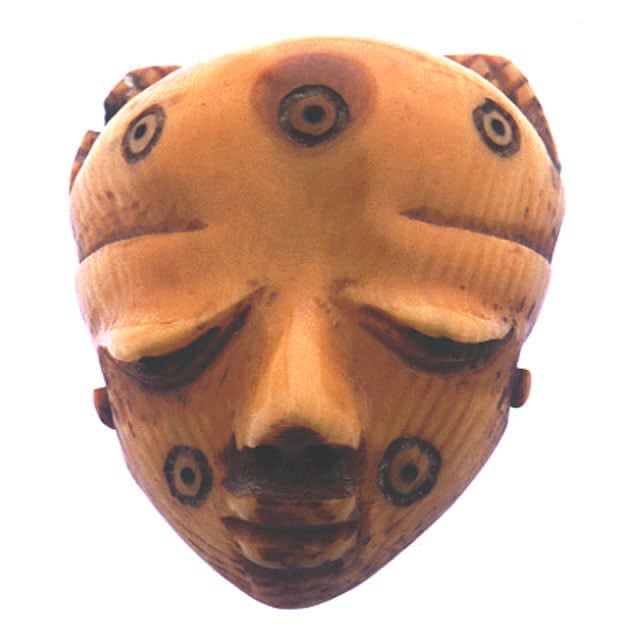Pende Ivory Ikhoko Mask Pendant, 20th Century CE
Ivory
1.5 x 1.75
PF.5375 (LSO)
This outstanding ivory pendant was made by the Pende of Gabon and Zaire. It is an Ikhoko piece, designed for adornment and also to denote high social status, as ivory...
This outstanding ivory pendant was made by the Pende of Gabon and Zaire. It is an Ikhoko piece, designed for adornment and also to denote high social status, as ivory was usually more valuable than gold. It was made by the Western Pende, as can be seen from the relatively small face, downcast eyes and the triangular nose. It is a simple oval shape with a broad brow and a pointed chin, but is highly decorated with incised cup-and-ring motifs on the cheeks and the forehead. The facial carving is serene and well-rendered.
The Pende live in the Loango and Kasai River area in what was once Zaire. They have a complex history of interaction with the Lunda Empire and the Tchokwe, and are affiliated with the Yaka and Suku, with which they share a common origin (Angola). They are governed by a loose network of localised chiefs (Djigo) and what essentially amounts to a landed aristocracy. Social structures – and thus most of their artworks – are centred on age groups which are circumcised and enter adulthood together, with what essentially amounts to a gerontocracy through the society. The spiritual welfare of Pende communities is controlled by family heads (usually the eldest maternal uncle of a family – the society is matrilineal) and village diviners. Ancestor spirits (mvumbi) are either good or bad, determined by the manner in which the ancestor died, and can harm the family unless appeased and cared for. Spirits may demand that the holy man make a sculpture, to which offerings are made.
So far as artistic production is concerned, the Pende are divided into Eastern and Western groups, although these divisions are socially artificial and the Pende consider themselves to be a single people. Pende figures are rare, and represent ancestors; some female sculptures have also been recovered, and are believed to be maternity figures. There are fifteen mask forms in the Western group, all of which are somewhat similar in possessing downcast eyes, protruding teeth and a triangular nose. The Eastern group possess only about four variants. A great deal of Pende art is basically regalia, including ivory mask pendants (Ikhoko), staffs, adzes, cups whistles and much else. This is an exceptional example of the former.
This was a status symbol at the time it was made, and remains an attractive and wearable piece of African art.
The Pende live in the Loango and Kasai River area in what was once Zaire. They have a complex history of interaction with the Lunda Empire and the Tchokwe, and are affiliated with the Yaka and Suku, with which they share a common origin (Angola). They are governed by a loose network of localised chiefs (Djigo) and what essentially amounts to a landed aristocracy. Social structures – and thus most of their artworks – are centred on age groups which are circumcised and enter adulthood together, with what essentially amounts to a gerontocracy through the society. The spiritual welfare of Pende communities is controlled by family heads (usually the eldest maternal uncle of a family – the society is matrilineal) and village diviners. Ancestor spirits (mvumbi) are either good or bad, determined by the manner in which the ancestor died, and can harm the family unless appeased and cared for. Spirits may demand that the holy man make a sculpture, to which offerings are made.
So far as artistic production is concerned, the Pende are divided into Eastern and Western groups, although these divisions are socially artificial and the Pende consider themselves to be a single people. Pende figures are rare, and represent ancestors; some female sculptures have also been recovered, and are believed to be maternity figures. There are fifteen mask forms in the Western group, all of which are somewhat similar in possessing downcast eyes, protruding teeth and a triangular nose. The Eastern group possess only about four variants. A great deal of Pende art is basically regalia, including ivory mask pendants (Ikhoko), staffs, adzes, cups whistles and much else. This is an exceptional example of the former.
This was a status symbol at the time it was made, and remains an attractive and wearable piece of African art.
